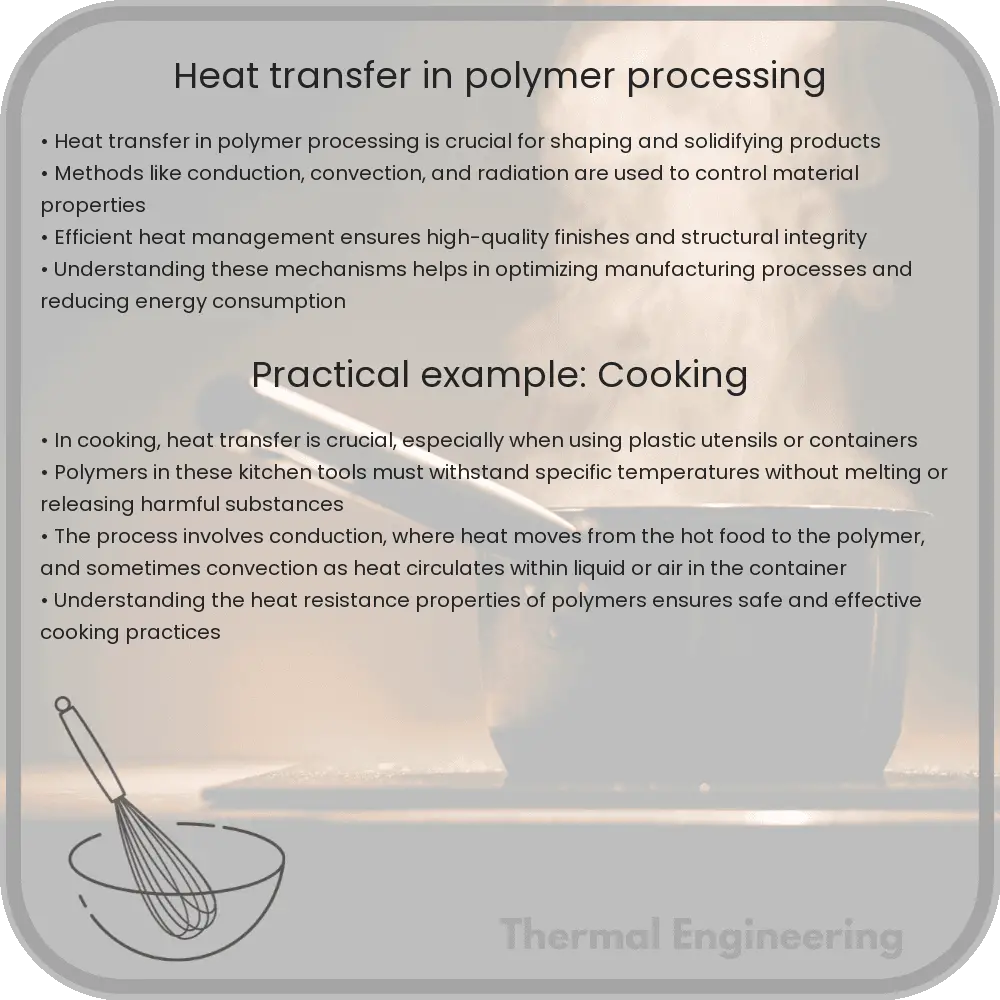Explore the crucial role of heat transfer types—conduction, convection, and radiation—in polymer processing to enhance product quality and efficiency.

Understanding Heat Transfer in Polymer Processing
Heat transfer is a fundamental aspect of polymer processing which significantly influences the quality, efficiency, and cost of manufacturing products. Polymers, such as plastics and resins, undergo various processes like extrusion, molding, and thermoforming, where heat transfer plays a crucial role. This article explores the types of heat transfer involved and how they impact polymer processing.
Types of Heat Transfer
In polymer processing, three main types of heat transfer occur:
- Conduction: This refers to heat moving through a solid material. When heat is applied to one part of a polymer chain, it gets transferred along the chain through vibrations of molecules.
- Convection: This happens when heat is carried away by a moving fluid, which can be a liquid or a gas. In the case of polymers, this is commonly air or water used to cool the material post-processing.
- Radiation: Heat can also be transferred through electromagnetic waves. Infrared heaters are often used in processes like plastic welding where radiation can efficiently transfer heat to the polymer.
The effectiveness of each heat transfer method depends on the properties of the polymer and the specific conditions of the process.
Equations and Concepts of Heat Transfer
Understanding the heat transfer in polymer processing can be approached by examining some key equations and concepts:
- Fourier’s Law of Heat Conduction: This law helps in calculating the heat transfer rate through materials and is given by the equation:
\[ q = -k \cdot A \cdot \frac{dT}{dx} \]
Here, q is the heat transfer rate, k is the thermal conductivity of the material, A is the area through which heat is being transferred, and \(\frac{dT}{dx}\) is the temperature gradient.
- Newton’s Law of Cooling: This law is used to calculate the rate of heat transfer by convection and is expressed as:
\[ Q = h \cdot A \cdot (T_{surface} – T_{fluid}) \]
Here, Q is the heat transfer rate, h is the heat transfer coefficient, Tsurface is the surface temperature of the material, and Tfluid is the temperature of the fluid.
- Stefan-Boltzmann Law: Relevant in heat transfer by radiation, it is given by:
\[ Q = \epsilon \cdot \sigma \cdot A \cdot (T^4 – T_{surrounding}^4) \]
Here, Q indicates the heat transfer rate, \(\epsilon\) is the emissivity of the material, \(\sigma\) is the Stefan-Boltzmann constant, T is the temperature of the material, and Tsurrounding is the surrounding temperature.
Practical Applications in Polymer Processing
Each heat transfer method is applied differently based on the polymer processing technique:
- Extrusion: Conduction is primarily used to heat the polymer through heated barrels and screws. Convection plays a role during the cooling phase where air or water cools the extruded polymer.
- Injection Molding: Here, conduction heats the polymer as it passes through heated sections of the mold. Convection cooling occurs as the polymer solidifies in the mold cavity.
- Blow Molding: Similar to injection molding, both conduction and convection are essential for heating the polymer and cooling the finished product, respectively.
- Thermoforming: Radiation often proves useful in rapidly heating sheets of plastic, followed by conduction to maintain the shape and convection to cool down the product.
Effective heat management ensures enhanced strength, clarity, and quality of the final polymer products, reducing defects like warping, sink marks, or incomplete curing. Understanding and controlling heat transfer is thus crucial for optimizing polymer processing operations.
Conclusion
Heat transfer in polymer processing involves complex interactions of conduction, convection, and radiation. Being versed with the theoretical aspects and practical implementations of these heat transfer methods allows engineers to design more efficient and higher quality polymer products. As such, mastering this element of polymer processing is indispensable for materials engineers and product designers alike.